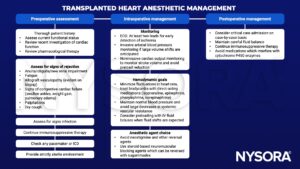Learning objectives
- Describe the hemodynamic implications of a transplanted heart
- Manage patients with a transplanted heart undergoing non-transplant surgery
Definition & mechanisms
- Cardiac transplant is the treatment of choice for many patients with severe cardiac failure who have failed medical therapy
- A transplanted heart has an absence of sensory, sympathetic, and parasympathetic innervation
- Due to a lack of parasympathetic innervation, vagal tone is lost and the resting heart rate will be 90–110 bpm
- Cardiac output of the transplanted heart is relatively dependent upon preload
- In response to hypovolemia, the cardiac output is increased by increasing the stroke volume rather than the heart rate and contractility, due to insensitivity to neurohormonal stimulation
- A degree of sympathetic and parasympathetic innervation develops with time (3+ years)
- The ECG in 80% of recipients will demonstrate two p-waves due to the posterior portion of the atrial walls being retained from the original heart
Management

Suggested reading
- Pollard BJ, Kitchen, G. Handbook of Clinical Anaesthesia. Fourth Edition. CRC Press. 2018. 978-1-4987-6289-2.
We would love to hear from you. If you should detect any errors, email us customerservice@nysora.com


